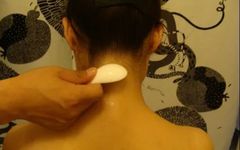
Click the blue text above to follow us


—— Gua Sha Therapy Suitable for Home Health Care
It is common to see elderly individuals using a spoon or water buffalo horn to scrape the skin on certain parts of the body, causing redness and the appearance of purple bruises or spots. This simple method of treating diseases is known as Gua Sha in Traditional Chinese Medicine (TCM).
Gua Sha is a TCM external treatment method that involves repeatedly scraping the skin with specific tools dipped in a scraping medium to treat diseases. It is based on the TCM theory of skin areas and uses specific tools (such as buffalo horn, jade, or coins) to scrape related areas of the skin, aiming to unblock meridians, relax muscles, dispel wind and cold, clear heat and dampness, invigorate blood circulation, and reduce swelling and pain.
As early as the Ming Dynasty, the physician Zhang Fengkui detailed the mechanism of Gua Sha in his work “Complete Book on Heat Stroke”. He believed that toxic evils enter through the skin and block the body’s meridians and blood flow, causing stagnation. The deeper the toxic evils penetrate, the more severe the accumulation, necessitating urgent measures, which include using Gua Sha to draw blood for treatment.
Modern renowned TCM practitioner Wu Shangxian fully endorsed Gua Sha, stating, “For abdominal pain due to Yang Sha, nothing is better than using a porcelain spoon dipped in fragrant oil to scrape the back, as the organs are connected to the back, and scraping will help dispel the evil qi, relieving the condition.”

 Indications for Gua Sha
Indications for Gua Sha
Gua Sha can be widely used for conditions such as colds, fevers, heat stroke, headaches, gastrointestinal disorders, stiff neck, shoulder periarthritis, lumbar muscle strain, muscle spasms, and rheumatoid arthritis. So, which areas of the body can be treated with Gua Sha, and how should the scraping areas be selected for related diseases?
Many areas of the body can be treated with Gua Sha, commonly including the neck and shoulders, both sides of the throat, the bends of the arms and legs, both sides of the spine, intercostal spaces in the front and back, above and below the shoulder blades, and areas with thick muscle and tendon attachments in the limbs.
Generally, the scraping should be done near the area of the disease, such as scraping the sides of the head and temples for headaches, the lower back for lumbar strain, and the neck for stiff neck; or based on the meridian and acupoint theory, such as scraping Zusanli (足三里) for stomach pain, Dazhui (大椎), Quchi (曲池), and Renzhong (人中) for heat stroke.。
 Basic Operation MethodClean the selected area, apply Gua Sha oil or massage oil, and then perform Gua Sha. Key points: Always scrape in one direction, do not scrape back and forth, and apply even and appropriate pressure, avoiding alternating between light and heavy pressure. If the scraping produces Sha (痧), continue scraping until dark purple streaks appear. If no Sha appears, a reddening of the skin is sufficient, and do not scrape for too long.
Basic Operation MethodClean the selected area, apply Gua Sha oil or massage oil, and then perform Gua Sha. Key points: Always scrape in one direction, do not scrape back and forth, and apply even and appropriate pressure, avoiding alternating between light and heavy pressure. If the scraping produces Sha (痧), continue scraping until dark purple streaks appear. If no Sha appears, a reddening of the skin is sufficient, and do not scrape for too long. Precautions1. When performing Gua Sha in cool weather, ensure warmth; in summer, avoid direct cold air from air conditioning or fans. Avoid bathing within two hours after producing Sha. 2. Do not perform Gua Sha again on the same area until the previous Sha marks have faded. 3. Use caution with elderly individuals and children with weak constitutions. If symptoms such as dizziness, pale complexion, palpitations, cold sweat, cold limbs, nausea, or fainting occur during Gua Sha, stop immediately and seek medical attention.
Precautions1. When performing Gua Sha in cool weather, ensure warmth; in summer, avoid direct cold air from air conditioning or fans. Avoid bathing within two hours after producing Sha. 2. Do not perform Gua Sha again on the same area until the previous Sha marks have faded. 3. Use caution with elderly individuals and children with weak constitutions. If symptoms such as dizziness, pale complexion, palpitations, cold sweat, cold limbs, nausea, or fainting occur during Gua Sha, stop immediately and seek medical attention.
● Liu Zhidan, Rehabilitation Medicine Department, Shanghai Baoshan District Integrated Traditional and Western Medicine Hospital

– End –
Previous Recommendations
Is the popularity of fascia guns based on lies?
Treatment and prevention of common office ailments—chronic lumbar muscle strain
Conditions like athlete’s foot and frostbite are prone to recurrence; seize the good opportunity of “treating winter diseases in summer”
Appreciation of modern TCM poetry in summer

